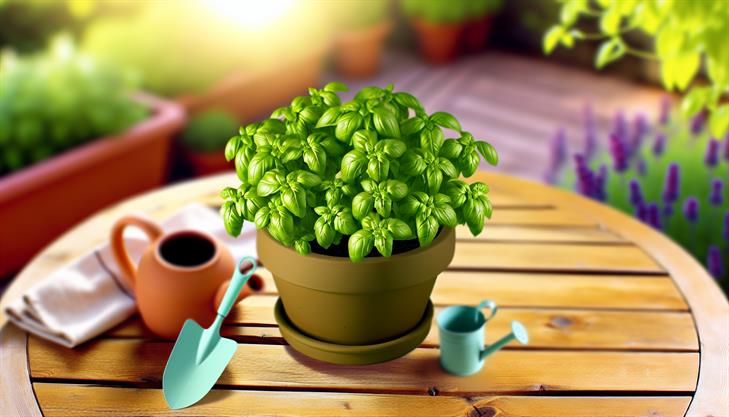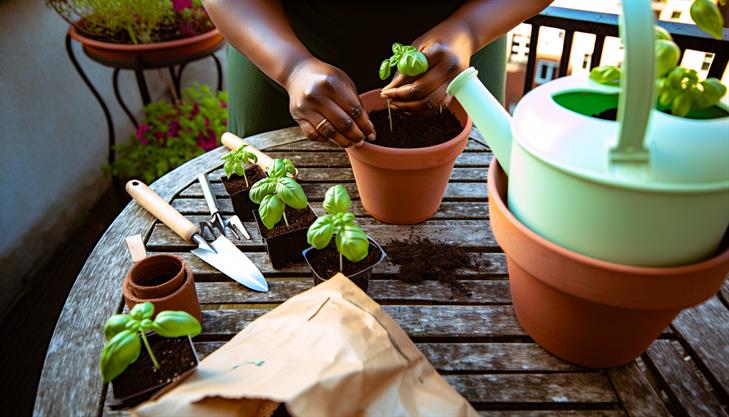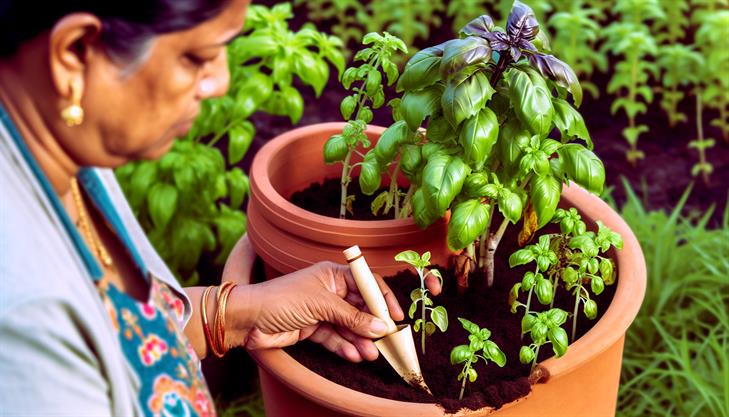Imagine stepping into your kitchen, the scent of fresh basil leaves dancing in the air as you prepare a delicious homemade meal. There’s nothing quite like the aromatic burst of flavor that fresh herbs bring to your dishes, and basil, with its vibrant green leaves and versatile profile, is a favorite among many home cooks and gardeners alike. But as you plan your herb garden, an important question arises: should you plant multiple basil plants in a single pot? This might seem like a simple query, but it can make a world of difference in the health and yield of your beloved basil.
In this guide, we delve into the nuances of basil planting, exploring both the science and art behind optimal growing conditions. Understanding how to plant basil effectively not only enhances the beauty of your indoor or outdoor garden but also ensures a bountiful supply of fresh basil for your culinary adventures. By reading this post, you’ll gain valuable insights into the best practices for maximizing your basil harvest, saving you time, space, and money. Whether you’re a novice gardener or a seasoned green-thumb, this exploration promises to enrich your gardening repertoire and spice up your home-cooked meals. So, grab your gardening gloves, and let’s get planting!
Understanding Basil’s Growing Needs
When considering whether to plant a lot of basil plants in one pot, it’s important to understand the specific needs and growth habits of basil. Basil thrives best when it has adequate space to spread its roots and receive sufficient nutrients. Here’s a comprehensive guide to help you decide how many basil plants you should place in a single pot and tips to ensure optimal growth.
1. Pot Selection:
- Size Matters: The first step in determining how many basil plants to put in one pot is choosing the right size. A good rule of thumb is to use a pot that is at least 12 inches in diameter if you plan to plant multiple basil shoots. This size ensures each plant can develop a healthy root system.
- Drainage: Ensure the pot has adequate drainage holes. Basil prefers well-draining soil to prevent root rot.
2. Spacing for Basil Success:
- Single Planting: For optimal growth, each basil plant should ideally have about 6 to 12 inches of space. If you decide to plant more than one in a pot, consider placing just two or three for a pot of the recommended size. This setup allows each plant to have enough room to grow without competing for resources.
- Crowding Issues: Planting too many basil plants in one pot can lead to overcrowding, which impacts their growth negatively. Crowded basil plants may become weak and leggy, as they compete fiercely for light, water, and nutrients.
3. Soil and Environment:
- Use a high-quality potting mix that retains some moisture but drains well.
- Sunlight: Basil requires at least 6 to 8 hours of sun daily, so ensure you place your pot in a well-lit area.
- Watering: Keep the soil consistently moist, but be cautious of over-watering, which could lead to root rot. Regular checks can help maintain the correct moisture level.
4. Planting Technique:
- Seeds or Seedlings: If starting with seeds, plant them about 1/4 inch deep and space them according to your pot size. If using seedlings, gently place them into the soil, ensuring they are at the same depth as they were in their original container.
- Thinning Out: Once seedlings have sprouted, thin them out to maintain the 6 to 12-inch spacing if necessary. This step reduces competition and promotes healthier growth.
5. Maintenance and Care:
- Pruning: Regular pruning encourages bushier growth and can prevent the plants from becoming too tall and top-heavy.
- Fertilization: Feed the plants with a liquid fertilizer every few weeks to ensure they have all necessary nutrients, especially if you notice leaves yellowing.
6. Common Issues:
- Pests: Watch out for common basil pests like aphids and spider mites. You can often control these with a mild insecticidal soap or neem oil.
- Disease: Ensure good air circulation around plants to prevent diseases such as powdery mildew or downy mildew.
By understanding the environmental needs and taking these considerations into account, you can make an informed decision about the optimal number of basil plants that can thrive together in one pot. This balanced approach helps achieve a productive and healthy basil garden, whether indoors or outdoors.
Best Practices for Planting Basil in Pots
Planting basil in pots is a fantastic option for gardeners with limited space or those who want to keep fresh herbs readily available. However, when considering whether you should plant a lot of basils in one pot, you need to take into account several important factors to ensure healthy growth and a bountiful harvest.
Space Requirements and Plant Number
The primary consideration when determining whether to plant numerous basil plants in a single pot is the space each plant requires. Basil plants need room to grow their roots as well as sufficient airflow around their leaves to prevent disease. Typically, for best results, it’s advisable to limit the number of basil plants to one or two per medium-sized pot, around 12 inches wide. If using a larger container, you can opt for three or four plants, provided you space them approximately 6-12 inches apart.
Step-by-Step Guide for Planting Basil in Pots
-
Choose the Right Pot: Ensure your pot is at least 12 inches in diameter with sufficient drainage holes to prevent waterlogging, which can cause root rot.
-
Select Quality Soil: Use high-quality potting soil mixed with compost to provide necessary nutrients. Basil thrives in well-drained, nutrient-rich soil.
-
Plant Your Basil:
- Seedlings or Seeds: If planting from seedlings, dig a hole as deep as the root ball, placing the plant gently, and covering it with soil. For seeds, plant them about 1/4 inch deep and cover lightly with soil.
- Spacing: Follow the recommended spacing of 6-12 inches between plants, ensuring they have room to grow and access light evenly.
-
Watering: Basil requires consistent moisture but avoid saturating the soil. Water deeply when the top inch of soil feels dry. Ensure your pot drains freely to avoid excess water retention.
-
Sunlight: Basil loves sunlight and grows best with 6-8 hours of direct sun a day. Place your pots on a sunny patio, balcony, or windowsill to maximize growth.
-
Fertilization: To promote lush foliage, apply a balanced, water-soluble fertilizer every 4-6 weeks during the growing season. Avoid over-fertilization, which can lead to leaf burn.
Common Issues and Solutions
-
Overcrowding: Planting too many basils in one pot can lead to competition for resources, resulting in spindly, weak plants. If plants appear stunted, consider thinning them out.
-
Pests: Basil is susceptible to pests like aphids and spider mites. Regularly inspect leaves and treat infestations with insecticidal soap or neem oil.
-
Mildew: Poor air circulation can lead to powdery mildew. Ensure adequate spacing and remove any yellowing or diseased leaves promptly.
Additional Tips for Success
-
Pruning: Regularly pinch off the top leaves to encourage bushier plants. Once flowers begin to form, remove them to maintain leaf production.
-
Seasonality: Basil is sensitive to cold. Consider bringing pots indoors during cooler months or transferring plants to an indoor herb garden setup.
In conclusion, while it might seem appealing to have a luscious pot overflowing with basil, careful consideration of plant spacing and pot size will reward you with healthier plants and a more productive herb garden. By following these best practices, you will successfully cultivate thriving basil plants in containers, providing a continuous supply of fresh herbs for your culinary creations.
Tips for Maximizing Basil Growth in a Single Pot
Planting basil in a single pot can be an efficient way to maximize your herb garden space, but it’s important to consider a few factors before you decide on the number of basil plants to cultivate. If you’re wondering, "Should I plant a lot of basils in one pot?" the answer largely depends on the size of the pot you have and your goals for the basil.
Choosing the Right Pot
To begin with, selecting the appropriate pot size is crucial. Basil plants require adequate space to grow and thrive. Each plant should ideally have around 12 inches of space around it. If you plant too many basils in a small pot, they will compete for nutrients, water, and sunlight, which might stunt their growth and result in weaker plants. A large container, about 12-18 inches in diameter, can comfortably support two to three basil plants.
Steps for Planting Basil in a Pot
-
Select the Pot: Choose a pot with drainage holes at the bottom to prevent waterlogging, which can lead to root rot. Ensure the pot is deep enough to accommodate the roots of the growing basil.
-
Prepare the Soil: Use high-quality potting soil mixed with compost. Basil thrives in nutrient-rich, well-draining soil. Adding a slow-release fertilizer can also help in providing the necessary nutrients throughout the growing season.
-
Planting the Seeds or Seedlings: If you’re using seeds, sow them about 1/4-inch deep and 2 inches apart initially. If you’re planting seedlings, ensure you gently remove them from their nursery pots and space them appropriately based on your pot size.
-
Watering: Water the basil thoroughly after planting. Basil likes to be moist but not overly wet. Water when the top inch of soil feels dry, and ensure any excess water can escape via the drainage holes.
-
Sunlight Requirement: Place the pot in a location where it gets plenty of sunlight—basil loves sunshine and needs at least 6-8 hours of direct sunlight daily. If indoor space limits access to sunlight, consider using a grow light.
Common Issues
Planting many basil plants too close together can lead to several issues:
-
Competition for Resources: Too many plants in one pot will compete for light, water, and nutrients.
-
Fungal Diseases: Crowded setups can create humid conditions, fostering fungal diseases like downy mildew.
-
Weak Growth: Insufficient space can lead to spindly, weak growth that affects the flavor quality of the basil leaves.
Additional Tips
-
Pruning: Regularly prune your basil to encourage bushy growth. Pinch off the tops of the plants to prevent them from flowering, which can change the flavor of the leaves.
-
Avoiding Overcrowding: If you’re restricted to a single pot and want a lot of basil, consider successive planting with staggered sowing times to ensure continuous production without overcrowding.
Ultimately, while you can plant multiple basil plants in one pot, ensuring they have adequate space, nutrition, and care is pivotal for robust growth. Balancing these elements will allow you to enjoy a lush and productive basil crop throughout the season.
Maintaining Healthy Basil: Common Issues and Solutions
Deciding how many basil plants to place in a single pot can significantly impact their health and productivity. While it might be tempting to plant a lot of basil in one pot to maximize your herb garden or save space, it’s essential to understand the potential effects on plant growth and overall quality.
Space and Air Circulation
Basil plants need adequate space and proper air circulation to thrive. When too many basil plants are crowded into one pot, they compete for nutrients, water, and sunlight. This competition can lead to spindly growth, smaller leaves, and a general decline in plant vigor. To avoid this, it’s wise to plant fewer basil plants per pot.
Recommended Setup
-
Choose the Right Pot Size: For optimal growth, select a pot that is at least 12 inches in diameter for a single basil plant or for a small cluster of up to three plants. This ensures that each plant has enough space to grow robustly.
-
Spacing: If multiple plants are desired, maintain a spacing of approximately 6-8 inches between each basil plant. This allows each plant to access ample nutrients and light, while promoting air flow to reduce disease risk.
-
Soil: Use high-quality potting soil that drains well. Overcrowding can exacerbate water retention issues, leading to root rot.
Watering and Nutrition
When thinking about whether to plant a lot of basil together, also consider their increased need for water and nutrients. Crowded plants require more frequent watering and fertilizing.
-
Watering: Basil prefers consistently moist soil, but the risk of overwatering increases with crowded planting. To avoid this, check the soil moisture regularly and water when the top inch of soil feels dry.
-
Fertilization: Use a balanced, organic liquid fertilizer every 4-6 weeks. More plants in a pot may deplete the soil nutrients faster, so monitor the health of your basil and adjust feeding schedules as necessary.
Common Issues
Disease and Pests: Overcrowded basil plants are more prone to fungal diseases such as downy mildew due to poor air circulation. Aphids and other pests are also more challenging to manage in tightly packed conditions. Regularly inspect your plants for signs of trouble and take immediate action if you notice any issues.
Additional Advice
-
Pruning: Regularly prune basil plants to encourage bushy growth and to increase airflow between each plant. Removing the top few sets of leaves encourages the plant to produce more side shoots.
-
Companion Planting: If space allows, consider mixing basil with other compatible herbs like parsley or chives, ensuring not to overcrowd. These herbs can enhance the overall health of the pot and deter pests naturally.
Conclusion
Ultimately, when pondering "should I plant a lot of basils in one pot?" the answer leans towards moderation. Proper spacing, strategic care, and attentive maintenance will ensure your basil plants flourish and provide a bountiful harvest. By considering these factors carefully, gardeners can avoid common basil issues and enjoy healthy plants throughout the growing season.
Tools and Techniques for Optimal Basil Care
When considering whether to plant a lot of basil in one pot, gardeners often ponder the balance between maximizing space and ensuring each plant thrives. This question is pertinent for both rookie and seasoned gardeners looking to cultivate this popular herb successfully. Below is a comprehensive guide addressing this concern along with practical advice for optimal basil care.
Understanding Basil’s Growth Needs
Basil is a sun-loving herb that thrives in warm temperatures and well-draining soil. It requires adequate space for its roots to spread and grow, as well as sufficient airflow around the plant to prevent diseases.
Can You Plant Multiple Basil Plants in One Pot?
Yes, you can plant multiple basil plants in one pot; however, there are several factors you should consider to ensure each plant grows healthily.
-
Choosing the Right Pot Size:
- For multiple basil plants, opt for a pot that is at least 12 inches in diameter. This size provides enough space for approximately two to three plants to grow without competing for resources.
- Ensure the pot has proper drainage holes to prevent waterlogging, which can lead to root rot.
-
Spacing Considerations:
- Space each basil plant about 4-6 inches apart. This allows ample room for the roots to expand and ensures sunlight reaches all parts of the plant.
- While it might be tempting to pack in more plants, overcrowding can stress the plants and stifle their growth.
-
Soil Preparation:
- Use a high-quality, organic potting mix rich in nutrients. Basil thrives in soil that is well-draining yet retains enough moisture to remain consistently damp (not soggy).
- Amend the soil with a slow-release organic fertilizer to provide essential nutrients over time.
Common Issues and Solutions
-
Overcrowding Concerns:
Overcrowding can lead to poor air circulation, increasing susceptibility to fungal diseases like downy mildew. Ensure adequate spacing and pruning to enhance airflow. -
Root Competition:
If plants are too close, they may compete for nutrients and water, leading to weaker growth. Regularly check the moisture level and adjust your watering regime to cater to all plants.
Additional Tips for Thriving Basil
-
Regular Pruning:
- Pinching off the top leaves encourages bushier growth and prevents plants from flowering prematurely. Removing flowers also helps the plant focus on leaf production.
-
Consistent Watering:
- Basil prefers consistent moisture, so water when the top inch of soil feels dry. Be cautious of overwatering, as this can cause root rot.
-
Sunlight Exposure:
- Place your pot in a location that receives at least 6-8 hours of sunlight daily. If outdoor conditions aren’t suitable, consider supplementing with grow lights indoors.
Having multiple basil plants in one pot is feasible with careful planning and attention to each plant’s needs. By selecting the right pot size, maintaining appropriate spacing, and adhering to a regular care routine, you can successfully grow lush, vibrant basil perfect for culinary use. Whether you’re a culinary enthusiast or avid gardener, these tips will ensure your basil plants flourish throughout the growing season.
In conclusion, deciding whether to plant a lot of basil in one pot depends largely on your available space, the pot size, and the basil variety. We’ve explored how basil plants thrive best under certain conditions, requiring enough space to spread their roots and sufficient airflow to prevent mold and disease. Planting too many seeds in one pot might seem like a space-efficient solution, but it often leads to overcrowded plants competing for nutrients, resulting in stunted growth.
If you’re keen on maximizing your basil yield, consider using larger pots or dividing the basil across several containers. This approach not only promotes healthier growth but also grants you a succession of fresh basil throughout the season. Don’t forget the importance of regular watering and plenty of sunlight, which are crucial for robust basil plants.
As a final tip, try companion planting by incorporating herbs like parsley or cilantro with your basil. This method can deter certain pests and improve garden diversity, ultimately leading to a richer harvest. Now, armed with these insights, you’re ready to cultivate a thriving basil garden in whatever space you have. Happy planting!


